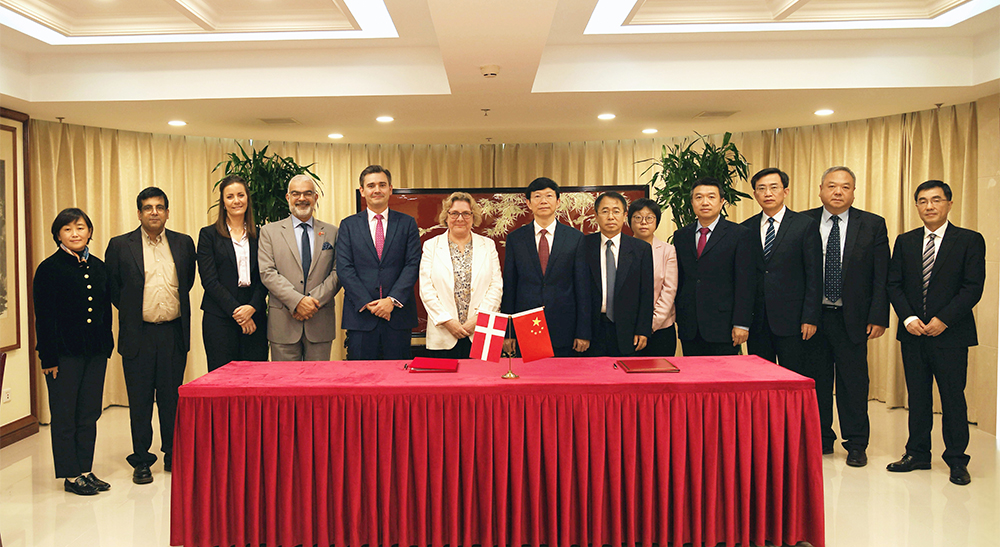张翊群:晚期黏膜黑色素瘤的治疗现状及展望
时间:2024-06-06 21:00:58 热度:37.1℃ 作者:网络
编者按:在亚洲人群中,黏膜黑色素瘤(mucosal melanoma,MM)占所有黑色素瘤的9.5%-22.6%[1-4],仅次于肢端黑色素瘤。随着靶向治疗和免疫治疗的出现,皮肤黑色素瘤治疗取得了进展,但是MM患者获益有限。本文回顾了MM的治疗现状,并提出了针对MM的潜在的治疗策略。
本期「专家组稿」由吉林大学第一医院吴荻教授担任执行主编,与吉林大学第一医院肿瘤内科张翊群医生共同分享晚期黏膜黑色素瘤的治疗现状及展望,为医者和患者提供更多参考。
治疗现状
1.化学治疗
对于晚期黑色素瘤,达卡巴嗪一直是最常用的化疗药物之一。以达卡巴嗪为基础的化疗治疗晚期MM的客观缓解率(objective response rate,ORR)为36%-47%,中位PFS为3-10个月,中位OS为9.6-22个月[5-8]。在MM占比更高的亚洲,以达卡巴嗪为基础的化疗仍然可以作为一线治疗选择。
2.免疫治疗
Ipilimumab作为第一个被证实可以延长黑色素瘤患者生存的免疫检查点抑制剂,对转移性MM的疗效并不理想。其作为晚期MM一线治疗的ORR为8.2%,中位PFS为3个月,中位OS为12个月,而后线治疗的ORR为6.7%-12.0%,中位PFS为4.3个月,中位OS为6.4个月[9-12]。
与ipilimumab相比,PD-1抑制剂在晚期MM患者中获得了更好的疗效,但依旧不尽如人意。PD-1抑制剂一线治疗晚期MM的ORR为20.0%-26.0%,中位PFS为5.9-6.2个月,中位OS为15.9-20.4个月[13-15],而后线治疗晚期MM的ORR为13.3%-19.0%,中位PFS为2.6-2.8个月,中位OS为7.4-11.5个月[16-19]。
3.分子靶向治疗
3.1 BRAF抑制剂 MM的BRAF突变频率仅为6%-17%[20-24],这限制了BRAF抑制剂在MM患者中的应用。仅一项回顾性研究显示,BRAF抑制剂治疗的BRAF突变的转移性/不可切除的MM患者的ORR为20%,中位 PFS为4.4个月,中位 OS为8.2个月[25]。
3.2 KIT抑制剂 KIT突变和扩增在MM中的频率为15%-39%[22,26]。目前常见的KIT抑制剂中,仅有imatinib和nilotinib在晚期MM中显现出一定疗效。Hodi等人发现,imatinib治疗KIT突变的晚期MM患者的ORR为64%,而对仅具有KIT扩增的患者疗效欠佳[27]。
对于imatinib治疗后进展的KIT突变的晚期MM,我们可以尝试nilotinib治疗。nilotinib治疗其他KIT抑制剂治疗后进展的晚期黑色素瘤患者的ORR为25%[28]。
4.联合治疗
4.1免疫联合治疗 CTLA-4和PD-1通过不同的机制抑制抗肿瘤免疫反应[29]。遗憾的是,CheckMate067研究显示,对于晚期MM患者,尽管nivolumab联合ipilimumab治疗的疗效优于ipilimumab,但对比nivolumab并无优势。
4.2免疫联合化学治疗 紫杉醇能够通过多种途径来诱导免疫原性细胞死亡和肿瘤细胞表面PD-L1表达[30-33]。Li JJ等人称,PD-1抑制剂联合白蛋白紫杉醇治疗晚期MM的ORR为33.3%,DCR为63.3%,中位PFS为4.9个月[34]。
4.3免疫联合抗血管生成治疗 抗血管生成药物可以通过促进抗肿瘤免疫来提高患者对ICIs的反应[35]。一项Ib期临床试验表明,在toripalimab联合axitinib治疗未经化疗的转移性MM患者的ORR为48.3%,中位PFS为7.5个月,中位OS为20.7个月[36]。另一项II期临床研究表明,atezolizumab联合bevacizumab治疗既往未经免疫治疗的不可切除/晚期MM的的ORR为45.0%,中位PFS为8.2个月,中位OS未达到[37]。目前尚未有研究结果表明PD-1和PD-L1抑制剂在与抗血管生成药物联合治疗晚期MM方面存在疗效上的差异。
4.4化疗联合免疫联合抗血管生成治疗 随着众多联合用药治疗的数据公布,人们正在考虑通过化疗、免疫及靶向联合治疗晚期MM。据2023年ASCO会议报道,一项camrelizumab联合anlotinib和nab-paclitaxel一线治疗晚期MM的单臂、多中心探索性研究正在进行(NCT04979585),期待其结果的发布。
未来展望
1.免疫治疗
1.1.新型瘤内免疫治疗 BO-112是Poly I:C(双链病毒RNA的类似物)与聚乙烯亚胺络合而成的纳米复合制剂,在肿瘤内释放时可增加T细胞介导的免疫反应,引起肿瘤细胞凋亡[38,39]。据2022年AACR年会报道,BO-112联合pembrolizumab治疗晚期MM患者的ORR为66%[40]。
1.2.新型细胞因子 Nemvaleukin alfa是一种新的工程细胞因子,可以激活CD8+ T细胞和自然杀伤细胞,减少调节性T细胞的增殖[41]。Nemvaleukin已被美国FDA批准为治疗MM的孤儿药。ARTISTRY-1研究(NCT02799095)表明,nemvaleukin alfa治疗ICIs治疗失败的晚期MM的ORR为33.3%。
1.3.TIL细胞疗法 Lifileucel作为一种自体肿瘤浸润淋巴细胞(tumor-infiltrating lymphocytes,TIL)疗法细胞疗法,使用集中制造工艺,利用从患者肿瘤组织中回收的TIL来制备多克隆的患者特异性TIL[42]。C-144-01研究表明,部分接受过免疫检查点抑制剂和BRAF/MEK抑制剂治疗的晚期MM患者在Lifileucel治疗后获得了持续临床缓解[43]。
2.免疫治疗失败后的DNA损伤修复
肿瘤细胞通常在DNA损伤反应 (DNA damage response,DDR)方面存在缺陷。DDR基因的改变可以促进PD-L1表达,提高肿瘤浸润淋巴细胞数量[44],增加肿瘤突变负荷,并通过增加新抗原负荷增强免疫原性[45],这些都是ICIs治疗反应的潜在决定因素。
RAD3相关蛋白激酶(Rad3-related protein kinase,ATR)是DDR通路的关键[46],其抑制剂有望用于MM治疗。一项II期临床试验表明,durvalumab联合ATR抑制剂ceralasertib治疗PD-1抑制剂治疗失败后的晚期MM患者的ORR为40%[47]。另一项I期研究表明,ceralasertib联合紫杉醇治疗抗PD-1治疗耐药的晚期MM患者的ORR为45.5%[48]。
MDM2可通过抑制p53功能从而抑制DDR[49],且MDM2扩增可能导致晚期MM对ICIs的反应更差[50]。Zhou R等人在50%的MM样本中观察到MDM2扩增[51]。这些使得MDM2成为MM的潜在治疗靶点。Alrizomadlin作为一种新型小分子MDM2抑制剂,可以恢复PD-1/PD-L1阻断失败的肿瘤患者的抗肿瘤活性[52]。据2021年ASCO年会报道,alrizomadlin与pembrolizumab联合治疗免疫治疗失败的晚期MM患者的ORR为40%(NCT03611868)。
总结
MM独特的基因组学特征和肿瘤免疫微环境导致其对当前免疫疗法以及其他系统治疗的反应较差,以ICIs为核心的联合治疗更有可能使患者获益。随着对MM的基因组学特征和肿瘤免疫微环境的深入了解,开发新的药物以及联合治疗方案以改善晚期MM患者生存将成为可能。
参考文献:
1. Fujisawa Y, Yoshikawa S, Minagawa A, et al. Clinical and histopathological characteristics and survival analysis of 4594 Japanese patients with melanoma. Cancer Med. 2019;8(5):2146-2156.
2. Tomizuka T, Namikawa K, Higashi T.Characteristics of melanoma in Japan: a nationwide registry analysis 2011-2013. Melanoma Res. 2017;27(5):492-497.
3. Teh YL, Goh WL, Tan SH, et al. Treatment and outcomes of melanoma in Asia: Results from the National Cancer Centre Singapore. Asia Pac J Clin Oncol. 2018;14(2):e95-e102.
4. Chi Z, Li S, Sheng X, et al. Clinical presentation, histology, and prognoses of malignant melanoma in ethnic Chinese: a study of 522 consecutive cases. BMC Cancer. 2011;11:85.
5. Yi JH, Yi SY, Lee HR, Lee SI, Lim DH, Kim JH, Park KW, Lee J. Dacarbazine-based chemotherapy as first-line treatment in noncutaneous metastatic melanoma: multicenter, retrospective analysis in Asia. Melanoma Res. 2011 Jun;21(3):223-7.
6. Kim KB, Sanguino AM, Hodges C, et al. Biochemotherapy in patients with metastatic anorectal mucosal melanoma. Cancer. 2004;100(7):1478-1483.
7. Bartell HL, Bedikian AY, Papadopoulos NE, et al. Biochemotherapy in patients with advanced head and neck mucosal melanoma. Head Neck. 2008;30(12):1592-1598.
8. Harting MS, Kim KB. Biochemotherapy in patients with advanced vulvovaginal mucosal melanoma. Melanoma Res. 2004;14(6):517-520.
9. Del Vecchio M, Di Guardo L, Ascierto PA, et al. Efficacy and safety of ipilimumab 3mg/kg in patients with pretreated, metastatic, mucosal melanoma. Eur J Cancer. 2014;50(1):121-127.
10. Postow MA, Luke JJ, Bluth MJ, et al. Ipilimumab for patients with advanced mucosal melanoma. Oncologist. 2013;18(6):726-732.
11. Yamazaki N, Kiyohara Y, Uhara H, et al. Real-world safety and efficacy data of ipilimumab in Japanese radically unresectable malignant melanoma patients: A postmarketing surveillance. J Dermatol. 2020;47(8):834-848.
12. Moya-Plana A, Herrera Gómez RG, Rossoni C, et al. Evaluation of the efficacy of immunotherapy for non-resectable mucosal melanoma. Cancer Immunol Immunother. 2019;68(7):1171-1178.
13. Nakamura Y, Namikawa K, Yoshikawa S, et al. Anti-PD-1 antibody monotherapy versus anti-PD-1 plus anti-CTLA-4 combination therapy as first-line immunotherapy in unresectable or metastatic mucosal melanoma: a retrospective, multicenter study of 329 Japanese cases (JMAC study). ESMO Open. 2021;6(6):100325.
14. Mignard C, Deschamps Huvier A, Gillibert A, et al. Efficacy of Immunotherapy in Patients with Metastatic Mucosal or Uveal Melanoma. J Oncol. 2018;2018:1908065.
15. Umeda Y, Yoshikawa S, Kiniwa Y, et al. Real-world efficacy of anti-PD-1 antibody or combined anti-PD-1 plus anti-CTLA-4 antibodies, with or without radiotherapy, in advanced mucosal melanoma patients: A retrospective, multicenter study. Eur J Cancer. 2021;157:361-372.
16. Kiyohara Y, Uhara H, Ito Y, Matsumoto N, Tsuchida T, Yamazaki N. Safety and efficacy of nivolumab in Japanese patients with malignant melanoma: An interim analysis of a postmarketing surveillance. J Dermatol. 2018;45(4):408-415.
17. Nathan P, Ascierto PA, Haanen J, et al. Safety and efficacy of nivolumab in patients with rare melanoma subtypes who progressed on or after ipilimumab treatment: a single-arm, open-label, phase II study (CheckMate 172). Eur J Cancer. 2019;119:168-178.
18. Hamid O, Robert C, Ribas A, et al. Antitumour activity of pembrolizumab in advanced mucosal melanoma: a post-hoc analysis of KEYNOTE-001, 002, 006. Br J Cancer. 2018;119(6):670-674.
19. Si L, Zhang X, Shu Y, et al. Pembrolizumab in Chinese patients with advanced melanoma: 3-year follow-up of the KEYNOTE-151 study. Front Immunol. 2022;13:882471.
20. Dumaz N, Jouenne F, Delyon J, Mourah S, Bensussan A, Lebbé C. Atypical BRAF and NRAS Mutations in Mucosal Melanoma. Cancers (Basel). 2019;11(8):1133.
21. Bryce AH, Arguello D, Millis SZ, et al. Multiplatform biomarker analysis on non-sun exposed mucosal melanoma. J Clin Oncol. 2015;33(15_suppl):9042-9042.
22. Nassar KW, Tan AC. The mutational landscape of mucosal melanoma. Semin Cancer Biol. 2020;61:139-148.
23. Wang HY, Liu Y, Deng L, et al. Clinical significance of genetic profiling based on different anatomic sites in patients with mucosal melanoma who received or did not receive immune checkpoint inhibitors. Cancer Cell Int. 2023;23(1):187.
24. Cosgarea I, Ugurel S, Sucker A, et al. Targeted next generation sequencing of mucosal melanomas identifies frequent NF1 and RAS mutations. Oncotarget. 2017;8(25):40683-40692.
25. Bai X, Mao LL, Chi ZH, et al. BRAF inhibitors: efficacious and tolerable in BRAF-mutant acral and mucosal melanoma. Neoplasma. 2017;64(4):626-632.
26. Hintzsche JD, Gorden NT, Amato CM, et al. Whole-exome sequencing identifies recurrent SF3B1 R625 mutation and comutation of NF1 and KIT in mucosal melanoma. Melanoma Res. 2017;27(3):189-199.
27. Hodi FS, Corless CL, Giobbie-Hurder A, et al. Imatinib for melanomas harboring mutationally activated or amplified KIT arising on mucosal, acral, and chronically sun-damaged skin. J Clin Oncol. 2013;31(26):3182-3190.
28. Carvajal RD, Lawrence DP, Weber JS, et al. Phase II Study of Nilotinib in Melanoma Harboring KIT Alterations Following Progression to Prior KIT Inhibition. Clin Cancer Res. 2015;21(10):2289-2296.
29. Buchbinder EI, Desai A. CTLA-4 and PD-1 Pathways: Similarities, Differences, and Implications of Their Inhibition. Am J Clin Oncol. 2016 Feb;39(1):98-106.
30. Garnett CT, Schlom J, Hodge JW. Combination of docetaxel and recombinant vaccine enhances T-cell responses and antitumor activity: effects of docetaxel on immune enhancement. Clin Cancer Res. 2008;14(11):3536-3544.
31. Hodge JW, Garnett CT, Farsaci B, et al. Chemotherapy-induced immunogenic modulation of tumor cells enhances killing by cytotoxic T lymphocytes and is distinct from immunogenic cell death. Int J Cancer. 2013;133(3):624-636.
32. Ng HY, Li J, Tao L, et al. Chemotherapeutic Treatments Increase PD-L1 Expression in Esophageal Squamous Cell Carcinoma through EGFR/ERK Activation. Transl Oncol. 2018;11(6):1323-1333.
33. Zhang P, Su DM, Liang M, Fu J. Chemopreventive agents induce programmed death-1-ligand 1 (PD-L1) surface expression in breast cancer cells and promote PD-L1-mediated T cell apoptosis. Mol Immunol. 2008;45(5):1470-1476.
34. Li JJ, Wang JH, Dingv Y, et al. Efficacy and safety of anti-PD-1 inhibitor combined with nab-paclitaxel in Chinese patients with refractory melanoma. J Cancer Res Clin Oncol. 2022;148(5):1159-1169.
35. Hack SP, Zhu AX, Wang Y. Augmenting Anticancer Immunity Through Combined Targeting of Angiogenic and PD-1/PD-L1 Pathways: Challenges and Opportunities. Front Immunol. 2020;11:598877.
36. Li S, Wu X, Yan X, et al. Toripalimab plus axitinib in patients with metastatic mucosal melanoma: 3-year survival update and biomarker analysis. J Immunother Cancer. 2022;10(2):e004036.
37. Mao L, Fang M, Chen Y, et al. Atezolizumab plus Bevacizumab in Patients with Unresectable or Metastatic Mucosal Melanoma: A Multicenter, Open-Label, Single-Arm Phase II Study. Clin Cancer Res. 2022;28(21):4642-4648.
38. Márquez-Rodas I, Longo F, Rodriguez-Ruiz ME, et al. Intratumoral nanoplexed poly I:C BO-112 in combination with systemic anti-PD-1 for patients with anti-PD-1-refractory tumors. Sci Transl Med. 2020;12(565):eabb0391.
39. Aznar MA, Planelles L, Perez-Olivares M, et al. Immunotherapeutic effects of intratumoral nanoplexed poly I:C. J Immunother Cancer. 2019;7(1):116.
40. Márquez-Rodas I, Dutriaux C, Saiag P, et al. Abstract CT014: Efficacy of intratumoral BO-112 with systemic pembrolizumab in patients with advanced melanoma refractory to anti-PD-1-based therapy: Final results of SPOTLIGHT203 phase 2 study. Cancer Res. 2022 June 15; 82 (12_Supplement): CT014.
41. Ko B, Takebe N, Andrews O, Makena MR, Chen AP. Rethinking Oncologic Treatment Strategies with Interleukin-2. Cells. 2023;12(9):1316.
42. Sarnaik AA, Hamid O, Khushalani NI, et al. Lifileucel, a Tumor-Infiltrating Lymphocyte Therapy, in Metastatic Melanoma [published correction appears in J Clin Oncol. 2021 Sep 10;39(26):2972]. J Clin Oncol. 2021;39(24):2656-2666.
43. Chesney J, Lewis KD, Kluger H, et al. Efficacy and safety of lifileucel, a one-time autologous tumor-infiltrating lymphocyte (TIL) cell therapy, in patients with advanced melanoma after progression on immune checkpoint inhibitors and targeted therapies: pooled analysis of consecutive cohorts of the C-144-01 study. J Immunother Cancer. 2022;10(12):e005755.
44. Jiang M, Jia K, Wang L, et al. Alterations of DNA damage response pathway: Biomarker and therapeutic strategy for cancer immunotherapy. Acta Pharm Sin B. 2021;11(10):2983-2994.
45. Chen X, Ou Z, Wang L, et al. Association of tumor mutational burden with genomic alterations in Chinese urothelial carcinoma. Mol Carcinog. 2022;61(3):311-321.
46. Maréchal A, Zou L. DNA damage sensing by the ATM and ATR kinases. Cold Spring Harb Perspect Biol. 2013 Sep 1;5(9):a012716.
47. Kim R, Kwon M, An M, et al. Phase II study of ceralasertib (AZD6738) in combination with durvalumab in patients with advanced/metastatic melanoma who have failed prior anti-PD-1 therapy. Ann Oncol. 2022;33(2):193-203.
48. Kim ST, Smith SA, Mortimer P, et al. Phase I Study of Ceralasertib (AZD6738), a Novel DNA Damage Repair Agent, in Combination with Weekly Paclitaxel in Refractory Cancer. Clin Cancer Res. 2021;27(17):4700-4709.
49. Loureiro JB, Raimundo L, Calheiros J, Carvalho C, Barcherini V, Lima NR, Gomes C, Almeida MI, Alves MG, Costa JL, Santos MMM, Saraiva L. Targeting p53 for Melanoma Treatment: Counteracting Tumour Proliferation, Dissemination and Therapeutic Resistance. Cancers (Basel). 2021 Apr 1;13(7):1648.
50. Forschner A, Hilke FJ, Bonzheim I, Gschwind A, Demidov G, Amaral T, Ossowski S, Riess O, Schroeder C, Martus P, Klumpp B, Gonzalez-Menendez I, Garbe C, Niessner H, Sinnberg T. MDM2, MDM4 and EGFR Amplifications and Hyperprogression in Metastatic Acral and Mucosal Melanoma. Cancers (Basel). 2020 Feb 26;12(3):540.
51. Zhou R, Shi C, Tao W, et al. Analysis of Mucosal Melanoma Whole-Genome Landscapes Reveals Clinically Relevant Genomic Aberrations. Clin Cancer Res. 2019;25(12):3548-3560.
52. Fang DD, Tang Q, Kong Y, et al. MDM2 inhibitor APG-115 synergizes with PD-1 blockade through enhancing antitumor immunity in the tumor microenvironment. J Immunother Cancer. 2019;7(1):327


